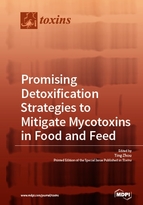Promising Detoxification Strategies to Mitigate Mycotoxins in Food and Feed
A special issue of Toxins (ISSN 2072-6651). This special issue belongs to the section "Mycotoxins".
Deadline for manuscript submissions: closed (31 January 2017) | Viewed by 155766
Special Issue Editor
Interests: mycotoxin detoxification; microbial detoxification; trichothecene mycotoxins; deoxynivalenol; patulin
Special Issues, Collections and Topics in MDPI journals
Special Issue Information
Dear Colleagues,
Mycotoxins are secondary fungal metabolites associated with adverse health and productivity consequences. Annual costs related to mycotoxins occurrences in food/feed are continuing to rise, causing the international economy to lose billions of dollars.
After more than three decades of mycotoxin mitigation research, our understanding started to reach a pinnacle, where biological and enzymatic means can be used to address such toxins. Moreover, advances in food and feed processing techniques, coupled with state-of-the-art molecular research tools, are leading the way for optimized empirical and feasible solutions.
The focus of this Special Issue of Toxins will be on the most recent advances related to mitigating mycotoxin contamination in food and feed. A particular survey of recent microbial and enzymatic strategies will be highlighted. The most promising techniques in food/feed processing will also be encouraged in this context. Finally, a whole section on some selected promising research tools that have the potential to revolutionize this field will be included. Both research (in particular) and review articles proposing novelties or overview, respectively, are welcome.
Dr. Ting Zhou
Guest Editor
Manuscript Submission Information
Manuscripts should be submitted online at www.mdpi.com by registering and logging in to this website. Once you are registered, click here to go to the submission form. Manuscripts can be submitted until the deadline. All submissions that pass pre-check are peer-reviewed. Accepted papers will be published continuously in the journal (as soon as accepted) and will be listed together on the special issue website. Research articles, review articles as well as short communications are invited. For planned papers, a title and short abstract (about 100 words) can be sent to the Editorial Office for announcement on this website.
Submitted manuscripts should not have been published previously, nor be under consideration for publication elsewhere (except conference proceedings papers). All manuscripts are thoroughly refereed through a double-blind peer-review process. A guide for authors and other relevant information for submission of manuscripts is available on the Instructions for Authors page. Toxins is an international peer-reviewed open access monthly journal published by MDPI.
Please visit the Instructions for Authors page before submitting a manuscript. The Article Processing Charge (APC) for publication in this open access journal is 2700 CHF (Swiss Francs). Submitted papers should be well formatted and use good English. Authors may use MDPI's English editing service prior to publication or during author revisions.
Keywords
- Microbial detoxification /degradation / transformation / conversion
- Enzymatic detoxification /degradation / transformation / conversion
- Biological detoxification / mitigation / decontamination
- Chemical detoxification /mitigation / decontamination
- Physical detoxification /mitigation / decontamination
- Toxicity of resulting metabolites
- Integrated mitigation
- Methodology development







